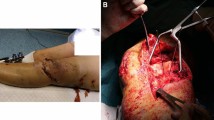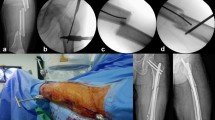Abstract
The objective of this study was to evaluate bony healing and predict factors affecting bony healing of femoral fractures treated with interlocking nailing (ILN) in static or dynamic conditions, and in reamed or unreamed procedures. Seventy-four femoral fractures (69 patients) were initially stabilized with ILNs in static condition. Among these fractures, ten static ILNs were dynamized after approximately 6 (median 6.4, range 1–13) months because of poor fracture healing. Reamed ILNs were performed for 55 fractures and unreamed ILNs for 19 fractures. Clinical and roentgenograhic processes were analyzed with emphasis on whether or not ILNs were dynamized. To evaluate any significant contributing factors affecting the nonunion of femoral shaft fractures treated with ILNs, logistic regression analysis was done. The union rates of static ILNs and dynamized ILNs were 92% (59/64) and 70% (7/10) respectively, but there was no significant difference between them. Five nonunions were seen in reamed ILNs and three in unreamed ILNs. The predictive logistic regression equation for nonunion was as follows: Log 1-p/p=1.05 −1.20 × AO/ASIF fracture grade in the femur −3.07 × existence of multiskeletal trauma in lower extremity + 0.06 × age −1.11 × smoking history −0.3 × existence of polytrauma −0.626 × the severity of soft tissue injury (p=0.002; each variable in the above equation was arranged according to the significant order). Among the variables, AO fracture grade (type C) in the femur and existence of multiskeletal trauma in lower extremity were significantly related to nonunion. Static ILN in most femoral shaft fractures does not inhibit the process of fracture healing. The following associated skeletal lesions were our concerns for nonunion and broken nail in static or dynamic ILNs: (1) C-type femoral fracture; and (2) existence of multiskeletal trauma, such as double lesions in the ipsilateral femur, floating knee injury, and bilateral femoral fractures.
Résume
L'objectif de cette étude est d'évaluer la consolidation osseuse et les facteurs prédictifs de cette consolidation, en ce qui concerne les fractures fémorales traitées par enclouage verrouillé (EV) aussi bien dans les dispositifs statiques que dynamiques et aussi bien avec ou sans alésage. Un total de 74 fractures (69 patients) initialement traités par EV statique a été étudié. De ces cas, 10 cas ont été dynamisés après 6 mois (moyenne : 6,4 mois – extrêmes : 1 à 13 mois) en raison d'une déficience du cal osseux. L'EV avec alésage a été réalisé dans 55 cas et sans dans 19 cas. Les données cliniques et radiologiques ont été étudiées en mettant l'accent sur l'existence ou non de dynamisation. Pour pouvoir évaluer le caractère significatif des facteurs responsables de pseudarthrose de la diaphyse fémorale traitées par EV, une analyse par régression a été effectuée. Les taux de consolidation des EV statiques et dynamiques ont été respectivement de 92 % (59/64) et de 70 % (7/10), mais aucune différence significative n'a été notée entre les deux groupes. Cinq pseudarthroses ont été relevées dans le groupe des EV avec alésage et trois dans les EV non alésées. L'équation de régression logique prédictive pour pseudarthrose a été la suivante : " Log 1-p/p=1,05 −1,20 × degré AO/ASIF pour le fémur −3,07 × par existence d'un traumatisme polyfracturaire du membre inférieur + 0,06 × par existence d'un polytraumatisme − 0,026 × par sévérité du traumatisme initial des tissus mous " (p=0,002, ; chaque variable dans l'équation ci-dessus ayant été classée par ordre de significativité). Parmi ces variables, les fractures fémorales de type C de la classification AO et l'existence de polyfractures du membre inférieur ont pu être reliées de façon significative à l'existence d'une pseudarthrose. L'utilisation d'un EV statique dans la majorité des fractures de la diaphyse fémorale n'inhibe pas la consolidation osseuse. Les lésions squelettiques associées suivantes ont été pour nous la cause des pseudarthroses et des fractures de clou aussi bien dans les EV avec alésage que dans les EV sans alésage pour les fractures fémorales : (1°) de type C et (2°) en cas d'existence de polyfractures, comme par exemple l'existence de double foyer dans le même fémur, une instabilité de genou ou bien une fracture fémorale bilatérale.
Similar content being viewed by others
References
Adachi K (1992) Influence of interlocking condition on the fracture healing process [in Japanese]. J Jpn Orthop Assoc 66:253–263
Baker SP, O'Neill B, Haddon W Jr, Long WB (1974) The injury severity score: a method of describing patients with multiple injuries and evaluating emergency care. J Trauma 14:187–196
Bone LB, Johnson KD, Weigelt J, Scheinberg R (1989) Early versus delayed stabilization of fractures: a prospective randomized study. J Bone Joint Surg [Am] 71:336–340
Brumback RJ, Umagieero S, Lakatos RP, Poka, A, Bathon GH, Burgess AR (1988) Intramedullary nailing of femoral shaft fractures. Part II: Fracture-healing with static interlocking fixation. J Bone Joint Surg [Am] 70:1453–1462
Brumback RJ, Ellison TS, Poka, A, Bathon GH, Burgess AR (1992) Intramedullary nailing of femoral shaft fractures. Part III: Long-term effects of static interlocking fixation. J Bone Joint Surg [Am] 74:106–112
Clayworthy, Clark DI, Gray DH, Hardy AE (1998) Reamed versus unreamed femoral nails. J Bone Joint Surg [Br] 80:485–489
Georgiadis GM, Minster GJ, Moed BR (1990) Effects of dynamization after interlocking tibial nailing: an experimental study in dogs. J Orthop Trauma 4:323–330
Green A, Trafton PG (1991) Early complications in management of open femur fractures: A retrospective study. J Orthop Trauma 5:51–56
Gustilo RB, Anderson JT (1976) Prevention of infection in treatment of one thousand and twenty-five open fractures of long bones. J Bone Joint Surg [Am] 58:453–458
Heckman JD, Ryaby J, Frey JJ, Kilcoyne RF (1994) Acceleration of tibial fracture-healing by non-invasive, low-intensity pulsed ultrasound. J Bone Joint Surg [Am] 76:26–34
Itoman M, Sasamoto N, Yamamoto M (1988) Stable osteosynthesis by interlocking cylinder nailing for fractures of the femur and tibia. J Jpn Orthop Assoc 62:601–608
Kempf I, Grosse A, Beck G (1985) Closed locked intramedullary nailing: its application to comminuted fractures of the femur. J Bone Joint Surg [Am] 67:709–720
Klein MPM, Rahn BA, Frigg R, Kessler SK, Perren SM (1990) Reaming versus non-reaming in medullary nailing: Interference with cortical circulation of the canine tibia. Arch Orthop Trauma Surg 109:314–316
Klemm KW, Borner M (1986) Interlocking nailing of complex fractures of the femur and tibia. Clin Orthop 212:89–100
Mabuchi K, Fujie H, Yamatoku Y, Yamamoto M, Sasada T (1992) A new methodology with an application of robotics to control the mechanical environment around experimentally fractured bone. In: Niwa A, Perren SM, Hattori T (eds) Biomechanics in orthopedics. Springer, Berlin Heidelberg New York, pp 183–193
Melcher GA, Metzdorf A, Schlegel U, Ziegler WJ, Perren SM, Printzen G (1995) Influence of reaming versus nonreaming in intramedullary nailing on local infection rate: Experimental investigation in rabbits. J Trauma 39:1123–1128
Müller ME (1991) The comprehensive classification of fractures of long bones. In: Müller ME, Allgöwer M, Schneider R, Willenneger H ( eds) Manual of internal fixation, 3rd edn, Springer, Berlin Heidelberg New York, pp 118–150
Nakamura T, Itoman M, Yokoyama K (1999) Cortical revascularization after reamed and unreamed intramedullary nailing in the rabbit femur: a microangiographic histometric analysis. J Trauma 47:744–751
Pape H-C, Dwenger A, Regel G, et al (1992) Pulmonary damage after intramedullary femoral nailing in traumatized sheep: Is there an effect from different nailing methods? J Trauma 33:574–581
Søbjerg JO, Eiskjaer S, Møller-Larsen F (1990) Locked nailing of comminuted and unstable fractures of the femur. J Bone Joint Surg [Br] 72:23–25
Takahashi S, Abe Y, Mori A, Watanabe K, Monma H, Imamura I (2000) Efficiency of dynamization after static locked intramedullary nailing for femoral shaft fractures [in Japanese]. Kossetsu 22:206–210
Tornetta P III, Tiburzi D (2000) Reamed versus nonreamed anterograde femoral nailing. J Orthop Trauma 14:15–19
Wu C-C (1997) The effect of dynamization on slowing the healing of femur shaft fractures after interlocking nail. J Trauma 43:263–267
Yokoyama K, Itoman M, Shindo M, Kai H, Ueta S, Kobayashi A (1999) Deep infection and fracture healing in immediate and delayed locked intramedullary nailing for open femoral fractures. Orthopedics 22:485–490
Author information
Authors and Affiliations
Corresponding author
Additional information
No benefits in any form have been received or will be received from a commercial party related directly or indirectly to the subject of this article.
Rights and permissions
About this article
Cite this article
Yokoyama, K., Itoman, M., Nakamura, K. et al. Contributing factors affecting initial bony healing in interlocking nailings for femoral shaft fractures. Eur J Orthop Surg Traumatol 13, 33–37 (2003). https://doi.org/10.1007/s00590-003-0064-7
Received:
Accepted:
Published:
Issue Date:
DOI: https://doi.org/10.1007/s00590-003-0064-7




